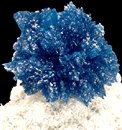|
|
| Formula: | Ca(VO)(Si4O10)•4H2O |  Click to see a larger image |
||
| Crystal: | Orthorhombic | |||
| Hardness: | 3-4 | |||
| Spec. Gr.: | 2.33 | |||
| Streak: | Blue | |||
| Cleavage: | Perfect in 1 direction | |||
| Location: | Wagholi Quarries, Poona, India |
| Cavansite, named for its chemical constituents Ca(VO)(Si4O10)•4H2O, was first described in 1968 by L.W. Staples. The type locality was a road cut near Owyhee Dam, Malheur County, Oregon. Cavansite occurs as extremely vivid shades of blue in parallel or radiating sprays, and sometimes as rosettes of acicular crystals. It associates with bladed or sheaf like white stilbite crystals for extremely attractive display specimens. In 1988, Cavansite matrixes of great beauty and in considerable numbers were found at the Wagholi quarry near Poona, India. These specimens remain the finest cavansites ever found, and are in great demand. |
|
Bibliography: Bireh, Bill., Cavansite from the Poona District, India. Mineralogical Record V8, No.1, pg. 61-62. Kothavala, Rustam, The Wagholi Cavansite Locality Near Poone, India. Mineralogical Record, V22, , pg. 415-420. |
|
University of California, Santa Barbara—Department of Earth Science Copyright © 2005 Regents of the University of California Send your comments to the Web Page Editor |